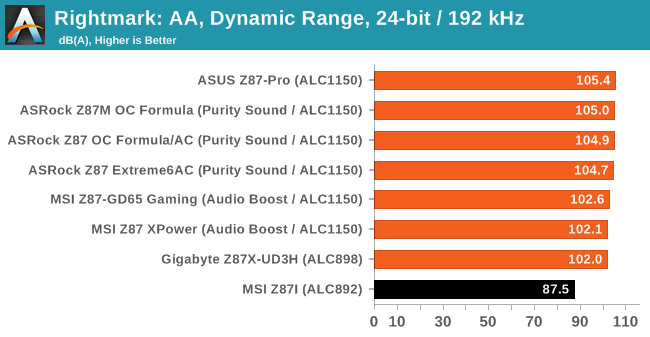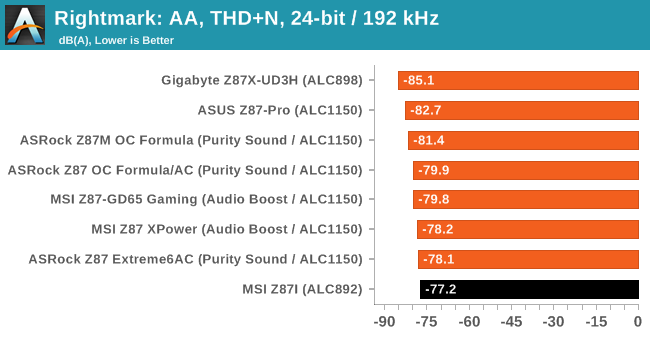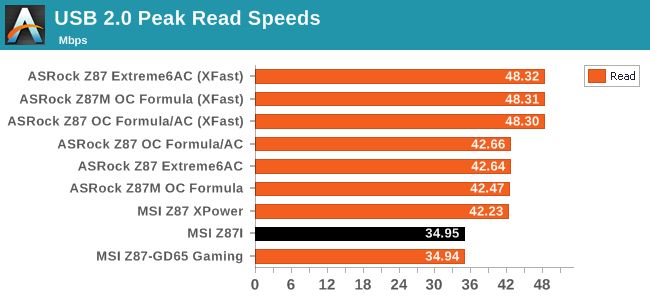MSI Z87I Review: Mini-ITX Haswell for $140
by Ian Cutress on August 27, 2013 10:15 AM EST- Posted in
- Motherboards
- MSI
- Mini ITX
- Z87
System Benchmarks
Rightmark Audio Analyzer 6.2.5
In part due to reader requests, we are pleased to include Rightmark Audio Analyzer results in our benchmark suite. The premise behind Rightmark:AA is to test the input and output of the audio system to determine noise levels, range, harmonic distortion, stereo crosstalk and so forth. Rightmark:AA should indicate how well the sound system is built and isolated from electrical interference (either internally or externally). For this test we connect the Line Out to the Line In using a short six inch 3.5mm to 3.5mm high-quality jack, turn the OS speaker volume to 100%, and run the Rightmark default test suite at 192 kHz, 24-bit. The OS is tuned to 192 kHz/24-bit input and output, and the Line-In volume is adjusted until we have the best RMAA value in the mini-pretest. We look specifically at the Dynamic Range of the audio codec used on board, as well as the Total Harmonic Distortion + Noise.


In terms of dynamic range, the ALC892 leaves a lot to be desired compared to the ALC898 and ALC1150.
USB Backup
For this benchmark, we run CrystalDiskMark to determine the ideal sequential read and write speeds for the USB port using our 240 GB OCZ Vertex3 SSD with a SATA 6 Gbps to USB 3.0 converter. Then we transfer a set size of files from the SSD to the USB drive using DiskBench, which monitors the time taken to transfer. The files transferred are a 1.52 GB set of 2867 files across 320 folders – 95% of these files are small typical website files, and the rest (90% of the size) are the videos used in the WinRAR test. In an update to pre-Z87 testing, we also run MaxCPU to load up one of the threads during the test which improves general performance up to 15% by causing all the internal pathways to run at full speed.


Nothing particularly special about USB speeds, in line with other Z87 MSI motherboards tested in the past.
DPC Latency
Deferred Procedure Call latency is a way in which Windows handles interrupt servicing. In order to wait for a processor to acknowledge the request, the system will queue all interrupt requests by priority. Critical interrupts will be handled as soon as possible, whereas lesser priority requests, such as audio, will be further down the line. So if the audio device requires data, it will have to wait until the request is processed before the buffer is filled. If the device drivers of higher priority components in a system are poorly implemented, this can cause delays in request scheduling and process time, resulting in an empty audio buffer – this leads to characteristic audible pauses, pops and clicks. Having a bigger buffer and correctly implemented system drivers obviously helps in this regard. The DPC latency checker measures how much time is processing DPCs from driver invocation – the lower the value will result in better audio transfer at smaller buffer sizes. Results are measured in microseconds and taken as the peak latency while cycling through a series of short HD videos - under 500 microseconds usually gets the green light, but the lower the better.

Peak DPC latency for Z87 platforms continues to poll over 145 microseconds, suggesting that is still a generational issue. If you want lower, then something other than Z87 might suffice.










46 Comments
View All Comments
BansheeX - Tuesday, August 27, 2013 - link
For $20 more, you can get the Asrock Z87E-ITX, which has an mSATA port on the back and a better audio DAC.abscoder - Wednesday, September 4, 2013 - link
+1 So far the Asrock Z87E-ITX has been serving me very well. Built a 12TB HTPC/file server around one.Hixbot - Thursday, September 5, 2013 - link
I personally have no need for a DAC on my motherboard. I'll use the digital output and my own DAC thank-you very much.8steve8 - Wednesday, August 28, 2013 - link
is this shipping with the c2 stepping?the tech media is amazingly quiet about the usb3 lga1150 bug... and the coming fix.
they are also quiet about i7-4770r lack of availability, along with any iris pro solution actually being buyable... is everyone waiting for c2 chipsets to launch significant products with haswell?
meacupla - Wednesday, August 28, 2013 - link
The reason for that is because the Haswell USB3.0 bug is not that relevant in desktops. It affects notebooks more and only affects USB3.0 storage devices when waking up from an S3 state, in which the data becomes unreadable off of the device.So unless you never turn your computer off, always have some sort of USB3.0 device connected and set aggressive power saving, you will be completely unaffected by the bug.
i7-4770R is BGA and needs to be packaged together with a mobo, so it's only natural that it has a slower development cycle. It's also likely that it's going to get a similar treatment to NUC or BRIX, so that's going to be an even longer delay.
8steve8 - Thursday, August 29, 2013 - link
not relevant on desktops? any computer that goes to s3 is effected...most people don't turn "off" their computer anymore... they let it idle and sleep.
lots of people use USB storage devices, when they plug in their phone its a usb storage device, their camera, their backup external HDD, etc.. some people use USB drives as their primary storage for music/movies..
you don't have to "always have" a usb device connected... just once... and you may see the bug.
I think more people should be aware of it, and yet no one is talking about it.... not enough.
It's on the worst thing in the world, but either is waiting a month or two for the fix.
I imagine apple is buying all the iris pro cpus up and will ship computers with them when c2 is ready...
8steve8 - Thursday, August 29, 2013 - link
correction:It's not the worst thing int he world, but either is waiting a month for the fixed hardware.
meacupla - Wednesday, August 28, 2013 - link
CPU socket area looks low, like the majority of Z77/H77 mITX boards that also couldn't fit a high performance dual tower heatsink.lopper - Wednesday, August 28, 2013 - link
Wish my vishera could be in mini-itx without blowing itself up.jardows2 - Wednesday, August 28, 2013 - link
I stopped reading when I saw the mini pci-e slot taken up by a wireless card. It doesn't look like you could fit a mSATA card without interfering with the CPU Heatsink. Again, another model packing all sorts of features that I will not use.